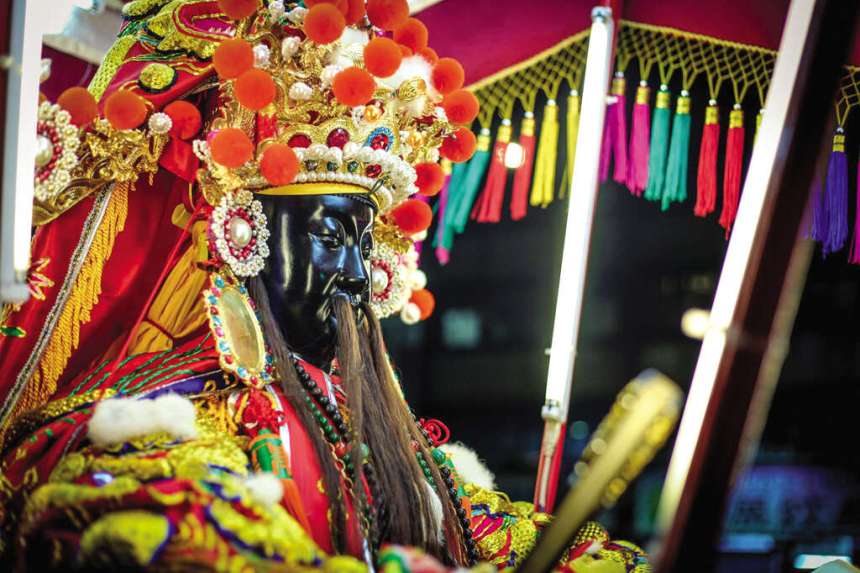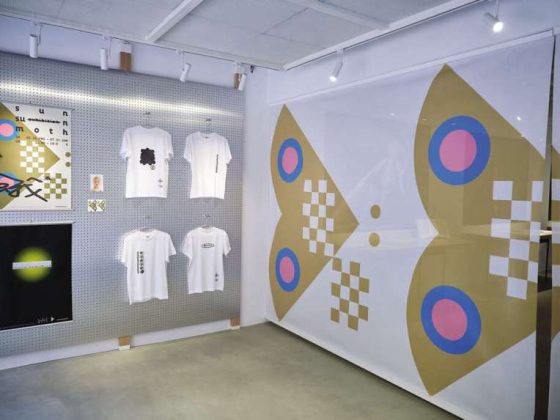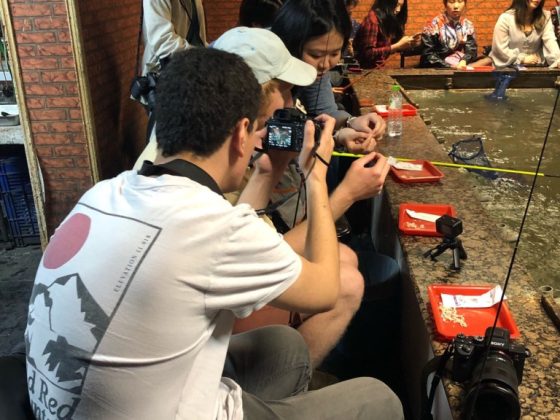WORDS BY Zhang Yinghua
PHOTOS BY The Qingshan Club of Bangka Qingshan Temple, Chiou Shih Chie
TRANSLATION BY Joe Henley
Bangka (艋舺) is an old area where Taipei originated and now known for its rich historical and cultural heritage. Not only are there various traditional foods hidden among the neighborhood’s labyrinth of alleys and lanes, but a wealth of popular temples sit in this area. Among these temples, Bangka Qingshan Temple (艋舺青山宮) on Guiyang Street (貴陽街) celebrate the birthday of its principal deity, King Lingan (靈安尊王) every year. A series of pilgrimages and religious activities are held from October 20 to 23 of the lunar calendar annually, collectively called “the Qingshan King Rituals” (青山王祭典), more commonly known as “the Grand Worship of Bangka” (艋舺大拜拜). The event attracts hordes of people every year and is one of the three major temple fairs of Taipei City, the other two being the celebration of the birthday of Xiahai City God (霞海城隍) in Dadaocheng (大稻埕) and the procession of Baosheng Emperor (保生大帝). (Read more: 13 Tips for having a deeper Taiwan Temple experience)

A DEITY WHO CROSSED THE STRAIT TO STOP THE PLAGUE IN TAIWAN
Bangka Qingshan Temple was built in 1856. Legend has it that in 1854, a group of migrant fishermen from Huian County (惠安縣), Fujian Province (福建省), officially invited King Lingan to Bangka. When the holy palanquin passed Old Street (today’s Xiyuan Road (西園路) section 1), it suddenly became too heavy to lift. After consulting the god’s will, the fishermen decided to build a temple on that very spot. This incident coincided with the time when Bangka was wracked by the plague. Miraculously, after the tormented locals paid tribute to King Lingan, they regained their health. Consequently, the deity’s believers multiplied and a new temple was erected at the new site at the current location.
The Qingshan Temple we see today was refurbished in 1938 in the style of palatial architecture of the Qing dynasty, which contains two halls, two corridors and a back-hall. The temple is recognized as a Level Three Ancient Monument by the Taipei City Government. In 2013, a fire destroyed many hundred-year-old deity statues and cultural relics preserved in Qingshan Temple. However, the horrible accident deepened the locals’ faith since they believed that it was a mysterious deed done by King Lingan to prevent an even more terrible catastrophe.
To show their gratitude for the deity’s kind gesture, residents of Bangka initiated the annual temple fair. The regular event has now become a uniting force in Bangka. In 1953, the Taipei City Government selected the Qingshan King Rituals as an autumn worship event in the then Longshan District, making Qingshan Temple one of two temples authorized to organize a temple fair in Taipei during the period of martial law. In 1975, the Qingshan King Rituals were listed as one of the seven major religious rituals in Taipei City, extending the pilgrimage to the whole range of today’s Wanhua District.
MIDNIGHT PATROL TO CAST AWAY FILTH IN THE REALMS OF THE LIVING AND THE DEAD

This year, the Qingshan King Rituals begin from November 16 of the western calendar (October 20 of the lunar calendar), and Qingshan Temple will invite Qingshui Zhshi (清水祖師) in Bangka Qingshui Temple (艋舺清水巖), Guanyin (觀音∕觀音佛祖) in Longshan Temple (艋舺龍山寺) and Mazu (媽祖∕天上聖母) in Taipei Tianhou Temple (台北天后宮) to be “guest gods” of Qingshan Temple and attend the whole ritual.
On November 16 and 17, King Lingan will lead his generals and soldiers on a “midnight patrol” (夜巡暗訪) in the southern and northern part of Wanhua District to inspect the realms of the living and the dead, cast away filth and evil, and arrest ruthless gods and marauding ghosts. On November 18, a large-scale midday pilgrimage (正日繞境) accompanied by parade formations from temples in northern Taiwan will take place. Local residents will set up tables and sacrifices along the route. Committee members of the temple like luzhu (censer master, 爐主) and toujia (local chiefs, 頭家) will build makeshift temples and stages where cabaret performers can sing and dance. The pilgrimage is always teeming with people who want to receive the god and express their joy for his birthday. The firecrackers set off along the way symbolize good luck. Believers who had made a pledge to King Lingan to return the favor after their wish was fulfilled will come back as jiangjiao (guards, 將腳) in red clothes and pants, wearing special straw sandals with facial painting. They will escort the holy palanquin in return for the deity’s kindness and push the atmosphere to a joyous climax.
THE EIGHT GENERALS IN RED AND GREEN PERFORM THE GHOST STEPS
The real eye-catcher during the midnight patrol and pilgrimage is “the eight generals of Qingshan Temple” (青山宮八將團). Equipped with intricate face paint designs, costumes, and instruments of torture adhering faithfully to traditional paraphernalia, the eight generals of Qingshan Temple are the most authentic parade formation. The group consists of four “red-faced generals” (紅面) and “four greenfaced generals” (綠面), a unique combination, and the only one of its kind left in Taiwan. The eight generals wear helmets and serve as guards clearing the way for the holy palanquin. They will perform ceremonial steps known as “the ghost steps” (鬼步), which are both domineering and impressive to protect King Lingan during the royal procession. In the center of the formation, there is one extra figure called the “guiding child” (引路童子). The guiding child is said to be the incarnation of a magical white crane. The guiding child wears a helmet and dons a royal robe. The gourd lantern in his hands helps guide the way for the eight generals. The eight generals of Qingshan Temple only show up for three days every year during the Qingshan King Rituals. They follow King Lingan of their own volition and, most important of all, their devotion and enthusiasm to serve. (Learn more about festival in Taiwan: The Mazu Pilgrimage Experience)

On the birthday of King Lingan, a ceremony held in the temple will be followed a magnificent birthday banquet on Guiyang Street, which will be closed to traffic beforehand. The banquet is just like a traditional Taiwanese catering party that opens to staff and other relevant people such as luzhu and toujia. During the banquet, local residents will toss moon blocks to determine the luzhu and toujia for the following year. Being nominated is regarded as a blessing and means one has been chosen by King Lingan.
“There is not much change in the way we hole these rituals. But the makeshift temples built along the route of the pilgrimage are more sophisticated these days. We also see people celebrating the event in different ways such as drum formations, singing, and pole dancing. People even rent fancy sports cars to accompany the pilgrimage parade. It just keeps getting livelier,” says Cheng Yumin (陳玉敏), secretary of Qingshan Temple.
Moreover, during the pilgrimage every year, committee members will make a palanquin and put their kids on it to hand out a kind of Taiwanese begals to other worshipers. In the early days, the palanquin was lifted by men, and now people have switched to using a tricycle palanquin. Around two decades ago, residents living nearby would hold a joint “catering party” on the same day of the birthday banquet, but the scene is now a thing of the past due to evolving customs changes.
GREEN PILGRIMAGE
In response to environmental concerns, Qingshan Temple now requests luzhu and toujia to lower the volume of late night performances and cut down on their use of firecrackers. To restore street view and keep the environment clean, Taipei City Government also arranges garbage trucks to gather firecrackers and trash right after the pilgrimage ended.
The Qingshan King Rituals stick to the most authentic and traditional form of religious ceremony and showcase the devotion of Bangka residents as well as their local culture. The rituals serve as an irreplaceable spiritual mainstay. People participate in the exciting event to seek inner peace, and the process has become an integral element and an intangible cultural asset of Taipei City.
More Festivals in Taiwan: Baosheng Cultural Festival: A Festive Event Full of History, Religion and Community
This article is reproduced under the permission of TAIPEI. Original content can be found at the website of Taipei Travel Net (www.travel.taipei/en).












